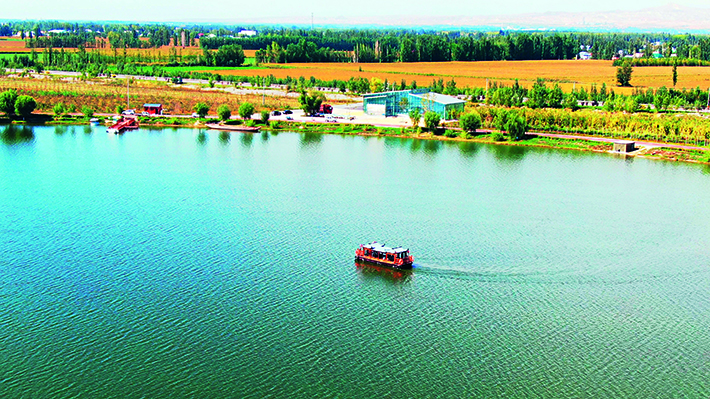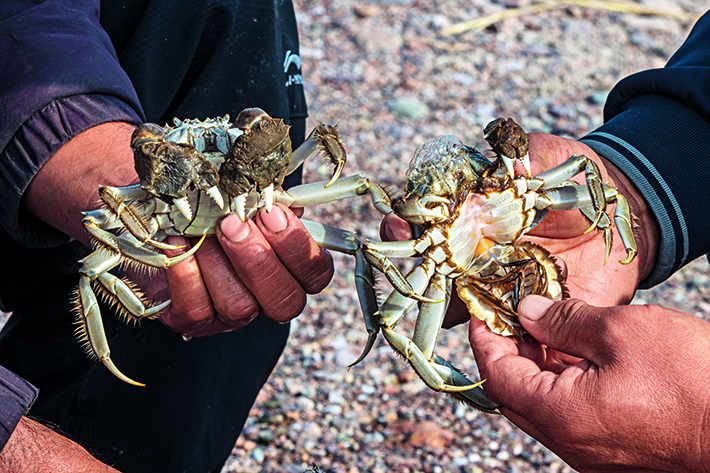|
||||||||||
| Home Nation World Business Opinion Lifestyle ChinAfrica Multimedia Columnists Documents Special Reports |
|
||||||||||
| Home Nation World Business Opinion Lifestyle ChinAfrica Multimedia Columnists Documents Special Reports |
| ChinAfrica |
| Marine Delicacies |
| Xinjiang’s aquatic products gain popularity in the domestic market |
| By Yang Shuangshuang | VOL. 16 March 2024 ·2024-03-13 |

A lake in Qapqal Xibe Autonomous County, Xinjiang Uygur Autonomous Region (COURTESY)
As a landlocked region, northwest China’s Xinjiang Uygur Autonomous Region is renowned for its fruits, vegetables, as well as beef and mutton. But in recent years, salmon, tilapia, crab, Australian lobster, and other marine delicacies from the region have not only made it to Chinese dining tables, but are also exported to other countries like Russia and Singapore. For those who think of the region as a land covered with saline-alkaline soil and the Gobi Desert, a question naturally arises: how can seafood be produced without the sea?
‘Seas’ in land
In fact, Xinjiang is not short of water, at least not as much as one might think. Its aquatic area covers 7,633 square km with numerous lakes. It is home to the Tarim River, China’s largest inland river, and the Irtych River, the country’s only river flowing into the Arctic Ocean. These rivers, fed by melting snow, and hosting over 500 species of microorganisms, are perfectly suited for cold-water fish farming.
Furthermore, the salinity of some lakes in Xinjiang far exceeds that of the sea. In fact, about 500 million years ago, this region was part of the ancient Mediterranean Sea and teemed with fish. Today, the sea has disappeared, but the salinity remains. This has allowed the creation of marine ecosystems by mimicking the mineral content of ocean water, introducing microorganisms, and cultivating algae. Vast expanses of saline-alkaline land have been transformed into aquaculture farms, producing seafood without the sea.
Guan Xiaoping, general manager of Yueran, a local ecological agriculture company, was thrilled with their gains from aquaculture. “We raised crabs in 69.2 hectares of rice fields in 2023, with an output of over 20 tonnes. High-quality crabs can be sold for 350 yuan ($48.7) per kg,” he said, showing a cage of crabs that had just been caught.
Qapqal Xibe Autonomous County, where the farms of the company are located, enjoys abundant sunlight, clear water, and ideal climatic conditions for aquaculture. With financial and technical support from a work team from Yancheng, Jiangsu Province, Guan is the first to breed crabs in Xinjiang.
In Guan’s aquaculture farm, rows of ponds and a network of inlet and outlet water channels form a complex system. Systems for both incoming water treatment and wastewater treatment have been installed, demonstrating a commitment to sustainability. In the breeding workshop, 30-square-metre pools line up in a row, resting on heating pipes that maintain a constant water temperature, filled with comfortably swimming young shrimp.
Since 2017, his company has introduced techniques to breed young crabs in workshops and raise adult ones in rice fields, increasing the survival rate of young crabs from less than 30 percent to over 70 percent and significantly reducing production costs.
Currently, Qapqal has over 113 hectares of rice fields for crab and crayfish farming, and 33 hectares of ponds for crab, white-leg shrimp, and giant freshwater prawn, among others. In early 2024, 11 tonnes of young crabs were put into ponds and rice fields. These efforts are expected to result in a production of 110 tonnes by the end of the year, with projected annual revenue exceeding 15 million yuan ($2.09 million).
Rapid time to market
“Our aquatic products are in high demand, and mainly sold to Jiangsu, Hunan, Shaanxi, Sichuan and Henan provinces,” Guan said, adding that air transportation is preferred to ensure freshness.
Previously, despite their quality, Xinjiang’s aquatic products struggled to enter the markets of other provinces due to high transportation costs and inadequate cold chain logistics. In recent years, amid a rapid growth of logistics industry, China Southern Airlines, SF Airlines and China Postal Airlines have all launched cargo services to Xinjiang, allowing for a timely transportation of shrimp and crabs to markets and homes in cities.
“I plan to raise our sales of salmon, shrimp and crabs via livestreaming,” Guan said. With the expansion of aquaculture in Qapqal, his company and two aquaculture cooperatives have created hundreds of jobs, with an average monthly salary of 4,500 to 6,000 yuan ($626-835) per person, helping the locals to become richer. Additionally, his company has invested nearly 4 million yuan ($560,632) in building a leisure complex, leveraging the privileged environment of its aquaculture farm, which offers sightseeing and fishing experiences.
Similar transformation is also found in Wenquan County on the edge of Sayram Lake. Its Cold-water Fish Park is home to species such as golden trout, rainbow trout and brook trout. Whether gracefully swimming in ornamental ponds, served on plates, or displayed in an exhibition hall, these fish captivate visitors.
The former cold-water fish breeding centre is now a national AAA-level tourist site. The combination of cold-water fish breeding and aquaculture with tourism has made it an ecotourism theme park and an important link in the local tourist circuit. In 2023, 13 million northern whitefishes raised in the park were released into Sayram Lake, yielding a harvest of 450 tonnes and revenue of 10 million yuan ($1.39 million) by the end of the year.

Crabs from an aquacultural farm in Qapqal Xibe Autonomous County, Xinjiang Uygur Autonomous Region (COURTESY)
Growing consumer needs
It is no coincidence that Xinjiang’s aquatic products are gaining popularity. Following Japan’s discharge of contaminated water from the Fukushima nuclear power plant, China suspended all imports of Japanese seafood, and Xinjiang filled the gap in the market.
More importantly, with the development of the Chinese economy, per-capita disposable income has increased, naturally leading to growth in seafood consumption. According to a market research report on seafood restoration published by the China Hospitality Association, the sector has an annual growth rate ranging from 10 percent to 30 percent, and the market will continue to grow.
“Giant freshwater prawns, Australian lobsters, and rainbow trout from Xinjiang are very popular now, and I will also try these high-end seafoods,” said a Beijing resident surnamed Feng, adding that she recently bought Xinjiang salmon on the Douyin e-commerce platform. In 2023, other e-commerce platforms such as Taobao, JD.com, and Pinduoduo also seized the opportunity of Xinjiang seafood going viral to introduce more gourmets to these aquatic delicacies at affordable prices.
According to a 2023 report on the development status of the Chinese seafood and aquaculture sectors released by industrial research institute Zhiyanzhan, the Chinese seafood market is expected to reach about 1 trillion yuan ($140 billion) in 2026. This reflects the increasing importance of seafood in Chinese diet, making the country one of the world’s largest consumers.
It is worth noting that Xinjiang’s aquatic products are already well-known internationally. Its perch and caviar delight palates in Finland and the Netherlands, while its Bosten Lake smelt accounts for over 70 percent of the Japanese market.
According to the Department of Agriculture and Rural Affairs of Xinjiang, the region’s fishing industry output will reach 20 billion yuan ($2.78 billion) by 2025. Thriving Xinjiang seafood is ready to cross the Tianshan Mountains and reach more corners of the world.
|
||
| About Us | Contact Us | Advertise with Us | Subscribe |
| Copyright Beijing Review All rights reserved 京ICP备08005356号-5 京公网安备110102005860号 |